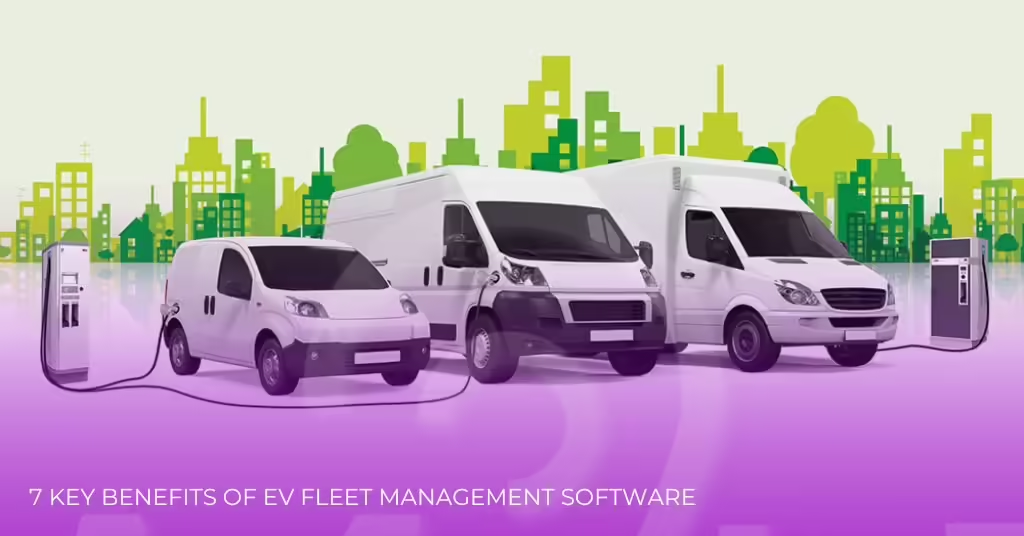ما هي فوائد برنامج إدارة أسطول السيارات الكهربائية؟
تعرف على سبعة فوائد رئيسية لبرنامج إدارة أسطول المركبات الكهربائية (EVFMS). تواصل مع Mile اليوم لدمج أسطول المركبات الكهربائية لديك مع حلنا المتخصص.
لقد بدأ عصر المركبات الكهربائية رسميًا، وجلب معه تحولًا جذريًا في قطاع النقل. وعلى الرغم من التكاليف الأولية المرتفعة، أصبح التحول إلى المركبات الكهربائية أكثر جدوى من أي وقت مضى. كما أن شحن المركبات الكهربائية أرخص نسبيًا وأكثر مراعاة للبيئة مقارنة بتكلفة تزويد المركبات التقليدية التي تعمل بالغاز.
مثل تغير المناخ ومع تزايد الاهتمام العام بالمشاكل البيئية، يفكر عدد متزايد من مشغلي الخدمات اللوجستية في كهربة الأساطيل كجزء من استراتيجيتهم المؤسسية المستدامة. كما يجري العمل على حظر المركبات ذات محرك الاحتراق الداخلي في العديد من البلدان، مما يعني أن الشركات ستضطر إلى البدء في التحول إلى المركبات الكهربائية عاجلاً أم آجلاً.
مع ذلك، قد يكون من الصعب إدارة أسطول المركبات الكهربائية مثل أي نوع آخر من الأساطيل. في هذه المرحلة، يصبح برنامج إدارة الأسطول المتخصص في المركبات الكهربائية هو الأكثر أهمية.
7 فوائد رئيسية لبرنامج إدارة أسطول المركبات الكهربائية (EVFMS)
إذا كان تحويل أسطولك إلى مركبات كهربائية كان يخطر ببالك مؤخرًا، فقد قمنا بتحديد سبع فوائد رئيسية لبرنامج إدارة أسطول المركبات الكهربائية أدناه لمساعدتك على اتخاذ القرار بسرعة وبثقة.
1: تتبع المركبات في الوقت الفعلي
هذه واحدة من أهم ميزات نظام إدارة شحن المركبات الكهربائية، لأنه يمنح مديري الأساطيل القدرة على رؤية مكان مركباتهم بالضبط في أي لحظة. كما يمكنهم مراقبة مستويات شحن المركبات الكهربائية، والمدى المتوقع، وعمر البطارية، والاستهلاك في الوقت الفعلي. إذا حدثت مشكلة غير متوقعة في شحن المركبة، يقوم البرنامج بإرسال إشعار إلى السائق، حتى لا يضطر إلى التعامل مع بطارية مستنفدة أول شيء في الصباح.
2: تخطيط مسار السيارة الكهربائية المتقدم
تعتمد المسافة التي يمكن أن تقطعها السيارة إلى حد كبير على سعة بطاريتها واستخدامها. أولاً، يستخدم نظام EVFMS المعلومات المتاحة القياس عن بعد وبيانات الجهات الخارجية لتقدير استهلاك الطاقة لأنواع مختلفة من المركبات وطرق التسليم. ثم يقوم بتحليل جوانب مثل حركة المرور والتضاريس وظروف الطقس لرسم خطة الرحلة المثلى الممكنة.
3: جداول الشحن
إن التأكد من شحن جميع المركبات الكهربائية بالكامل وتشغيلها يشكل دائمًا أولوية قصوى لمديري الأساطيل. وباستخدام أدوات إدارة الشحن المتقدمة من EVFMS، يمكنهم التخطيط لجداول شحن مثالية للأوقات التي تكون فيها الكهرباء أقل تكلفة، مثل خلال ساعات الذروة. كما توفر بعض البرامج للمديرين إمكانية الوصول عن بُعد، مما يسمح لهم ببدء أو إيقاف الشحن بناءً على الاحتياجات الفورية أو التغييرات في شبكة الطاقة.
4: وحدة إعادة الشحن
عندما يكون إعادة الشحن ضروريًا، يتضمن مخطط الرحلة تلقائيًا أقرب وأسرع محطات الشحن. ويمكن للسائق رؤية وقت الوصول المتوقع وأوقات الشحن لكل محطة والتحويل وفقًا لذلك. بالإضافة إلى استخدام البيانات الطوبولوجية لتعديل توقعات الشحن، يقوم البرنامج بتحديث وقت الوصول المقدر (ETA) استجابة لأي تحويلات من جانب السائق. تبدأ بطارية السيارة أيضًا في التسخين بمجرد اقتراب السائق من محطة الشحن. وهذا يحسن جودة الشحن ويقصر وقت الشحن.
5: وحدة التنبؤ بالمدى
يرتبط مدى السيارة الكهربائية بشكل مباشر بالأداء الذي تقدمه خلال عمرها الافتراضي. يستخدم نظام EVFMS الجيد تحليلات البيانات المدعومة بالذكاء الاصطناعي وخوارزميات التعلم الآلي لتقدير مدى القيادة للسيارة الكهربائية بدقة.
يعتمد التنبؤ بالمدى على عدد من العوامل مثل:
- تصميم المركبات
- سرعة السيارة
- مستوى شحن البطارية
- أنماط القيادة
- حالة الطريق
- طقس
- التضاريس
يقوم البرنامج بجمع كل هذه البيانات ومعالجتها للتنبؤ بالمسافة التي يمكن أن تقطعها السيارة دون الحاجة إلى التوقف لإعادة الشحن أو التحول إلى ممارسات القيادة المثلى (إيقاف تشغيل مكيف الهواء، والقيادة بسرعة منخفضة، وما إلى ذلك). كما يعمل البرنامج على تحسين تنبؤاته باستمرار بناءً على البيانات الجديدة وأنماط القيادة.
6: الصيانة في الوقت المناسب
على الرغم من أن المركبات الكهربائية تتطلب صيانة أقل بكثير من المركبات العادية، فمن الجيد دائمًا مراقبة التآكل والتلف. يحلل نظام إدارة المركبات الكهربائية اتجاهات استخدام المركبات وسجلات الصيانة ويرسل تنبيهات الصيانة التنبؤية لضمان قيام المديرين بجدولة خدمات الصيانة في الوقت المحدد والمساعدة في تجنب الأعطال المفاجئة على الطريق.
7: إدارة سلوك السائق
باستخدام نظام EVFMS، يمكنك اكتشاف ما إذا كان سائق معين يقود بسرعة كبيرة بشكل منتظم أو يضغط على المكابح بقوة شديدة. لتشجيع ثقافة السلامة، يمكنك مكافأة عادات القيادة الجيدة ومعاقبة التهور. مع العلم بوجود حوافز للقيادة بأمان، سيتصرف موظفو التوصيل لديك بمسؤولية على الطريق، مما يوفر لك الكثير من المال على إصلاحات المكابح وإعادة ضبطها والمزيد!
فوائد متنوعة
بالإضافة إلى الفوائد المذكورة أعلاه، يوفر لك برنامج إدارة أسطول المركبات الكهربائية أيضًا رؤى قابلة للتنفيذ يمكنك استخدامها للتخطيط لجداول الإرسال بشكل أفضل، وتوفير أوقات وصول متوقعة أكثر دقة، وتحديد المركبات التي تغادر الأسوار الجغرافية المصرح بها دون إشعار مسبق.
باستخدام شبكة من محطات الشحن، يمكنك مراقبة مدى توفر محطات الشحن الفردية واستخدامها وحالة عدم الاتصال في الوقت الفعلي. وبصرف النظر عن ذلك، يمكنك أتمتة عدد من عمليات الشحن، مثل:
- جدولة المركبات التي عادت للتو من رحلة الشحن؛
- إعطاء الأولوية للشحن السريع للمركبات الموجودة في الدوران؛
- صف المركبات غير العاملة في قائمة الانتظار للشحن خارج أوقات الذروة عندما تكون أسعار الطاقة أقل؛ و
- جمع بيانات الشحن من جميع المركبات لتحسين جداول الشحن.
يمكنك أيضًا استخدام ميزة إعداد التقارير والتحليلات في نظام إدارة قيمة المركبة الإلكتروني (EVFMS) لإنشاء تقارير شاملة حول أداء أسطولك واستخدام الشحن واستهلاك الطاقة والتكلفة لكل رحلة وما إلى ذلك. تأتي بعض أنظمة إدارة قيمة المركبة الإلكتروني (EVFMS) مع تطبيقات التجار والسائقين الأصلية لتبسيط كل من إدارة الطلبات ودورات التسليم. كما أن لديهم واجهات برمجة تطبيقات مريحة تتكامل مع سير العمل الحالية لتبسيط المدفوعات والمحاسبة وكشوف المرتبات.
هل تبحث عن نظام EVFMS لأسطولك؟ دعنا نتحدث.

